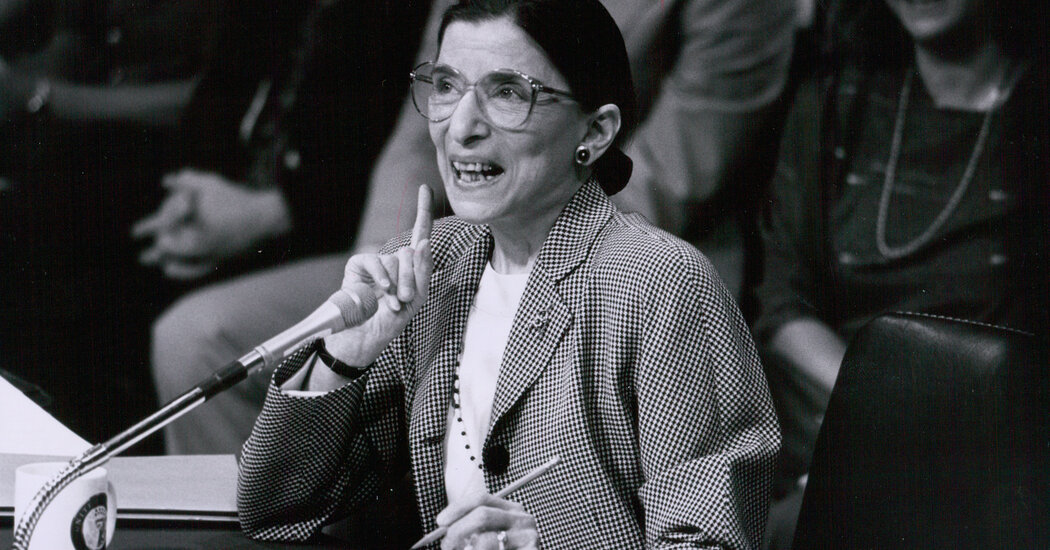More than 40 years after Ruth Bader Ginsburg last appeared as a lawyer at the Supreme Court, relatively few women argue cases there.
WASHINGTON — In her final appearance as a lawyer before the Supreme Court, in 1978, Ruth Bader Ginsburg argued in favor of the equal treatment of women in the justice system. She made her case to nine men.
In the years since, there have been five female justices, including Justice Ginsburg, who served from 1993 until her death in 2020. The current court includes three women.
Women have made less headway on the other side of the bench. In the term that ended in June, just 18 percent of arguments were presented by women, according to data compiled by Kimberly Strawbridge Robinson of Bloomberg Law.
A year before, the figure was 13 percent. Over the past decade, Ms. Robinson found, the percentage of female lawyers presenting arguments at the court ranged from 12 to 22 percent.
Those figures are similar to the ones at issue in Ms. Ginsburg’s 1978 argument, her only one on behalf of a criminal defendant. She represented Billy Duren, who had been convicted of murder in Missouri by an all-male jury. The state allowed women to opt out of jury service and most of them did, resulting in a jury pool that was about 85 percent male.
The case had two of the classic characteristics of the litigation strategy that made Ms. Ginsburg the leading women’s rights lawyer: Her client was a man, and the challenged law was based on a stereotype.
Mr. Duren, she said, was entitled “to a fair chance for a jury genuinely representative of the community’s complexion.” And the law allowing women an automatic exemption from jury service, she said, “simply reflects and perpetuates a certain way of thinking about women.”
“Women traditionally were deemed lesser citizens,” she said.
The justices, calling her “Mrs. Ginsburg,” said there might be good reasons for the law.
“Without getting into that old cliché about ‘woman’s place is in the home,’” Chief Justice Warren E. Burger asked, why shouldn’t states be allowed to decide that “mothers of small children belong at home, not serving on juries?”
Ms. Ginsburg gently suggested that men can take care of children, too.
“There are several states,” she said, “that have exemptions for persons primarily responsible for the care of young children.”
The point seemed to dawn on the chief justice. “So that’d be husbands or wives then,” he said.
Speaking slowly, as if to a dim student, she replied: “It could be husband or wife, yes.”
Years later, she reflected on the approach she used in the six cases she argued before the Supreme Court.
“I did see myself as kind of a kindergarten teacher in those days, because the judges didn’t think sex discrimination existed,” she said in the documentary “R.B.G.” “One of the things I tried to plant in their minds was, Think about how you would like the world to be for your daughters and granddaughters.”
More than 40 years later, progress has been halting, said Michael R. Dreeben, a former deputy solicitor general who has argued more than 100 cases before the Supreme Court and who examined the Duren case in an article in Criminal Justice, a magazine published by the American Bar Association.
“She accomplished this enormous legal victory, and she really transformed the way gender and the law are perceived, and she broke molds,” he said. “Yet the underlying stereotypical patterns have a much longer persistence in both law and practice.”
The most striking gap, Mr. Dreeben said, is among the elite lawyers who argue before the court.
“Obviously, there’s a lot of progress with one-third of the court being female,” he said. “But it’s not having nearly as great an effect on advocates.”
Mr. Dreeben, who is now a partner at O’Melveny & Myers, said the trend “is largely a function of caution on the part of corporate counsel who hire Supreme Court advocates.”
“Women are doing well in government and in public interest and are performing at an incredibly high level,” he said, “but the hiring patterns haven’t yet caught up to that.”
Lisa S. Blatt, a lawyer with Williams & Connolly who has argued more Supreme Court cases than any other woman, echoed the point in a 2010 article in The Green Bag, a legal journal.
“With very limited exceptions,” she wrote, “the women I see arguing before the court are public interest lawyers, public defenders representing the criminally convicted or government lawyers. Translation: Women are doing the same work but for less pay.”
As the argument in the 1978 case drew to a close, Justice William H. Rehnquist, who would become chief justice in 1986, jokingly suggested a compromise.
“You won’t settle for putting Susan B. Anthony on the new dollar, right?” he asked. There was nervous laughter in the courtroom, but Ms. Ginsburg did not respond.
Chief Justice Burger added his own odd comment. “I think you have no jurisdiction to make that concession, Mrs. Ginsburg,” he said.
Two months later, she won the case. Only Justice Rehnquist dissented.


























